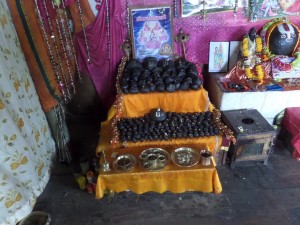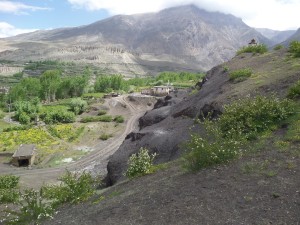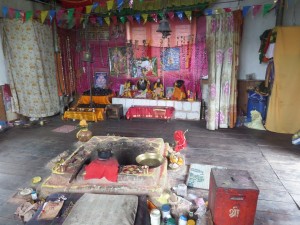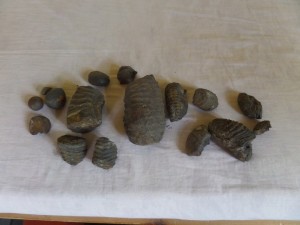Space and Movement. I can already see that these two concepts may well become the foundational framework for this project going forward. Space because religious co-participation in this region is highly contingent of the sharing of sacred places. Movement because it is through various types of motion (circumambulation, pilgrimage, travel of the sacred stones through the river, ritual movement through temple spaces, and returning home with sacred objects) that religious and national identities and boundaries are continuously negotiated. In short, this means that, at its heart, the blending of Hindu, Buddhist, and shamanic traditions in Mustang are largely brought about through the blending of various peoples in shared spaces that hold meanings at multiple levels. For example, the same object (say, a Shaligram Stone) means one thing to one person and another thing to another person, but what they agree on is the meaningful importance of the object, or the place, so in question. In additional to layers of economic exchange and the sharing of ethnic and national identities, this results in a kind of religious synthesis that produces traditions of worship that are both continuously exchanging characteristics and remaining linguistically and ontologically distinct from one another.
As one who is moving through these spaces herself, I had the opportunity yesterday, based on a local tip, to visit on the few mountain Shaligram beds. These black shale beds are used, primarily, by Buddhist stone sellers to mine sacred stones directly from the mountain-side rather than wait for stones to be found by stone hunter/wholesalers further down on the Kali-Gandaki river banks. The downfall here, while the shale beds produce many stones, is that Hindu pilgrims largely do not prefer these stones. Their sharp edges and broken chakras (shells) too often render them as “the blind eye” and are harder to sell because the deity represented within the stone cannot be accessed. This was even more strongly demonstrated when I was given access to the Shaligram Mandir at Muktinath by an elderly Shiva sadhu (holy man) tending the temple grounds. Each stone installed as a deity in this way is whole and without chip or blemish. This is typical of Shaligram Stones used in home worship and these are the stones Hindus come here to find.
Sadly, post-earthquake, there are few pilgrims visiting Muktinath this summer season, so I have not had as many opportunities as I would like to conduct interviews with Hindu pilgrims. My exchanges with local residents and with the sadhus and nuns minding the many temples and gompas scattered everywhere in this area have, however, been incredibly enlightening. For now, perhaps it is best that I get the lay of the land as those who live here know it, because tomorrow who knows how it may change.




